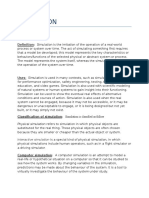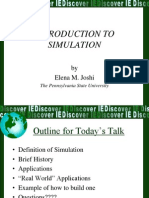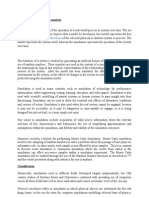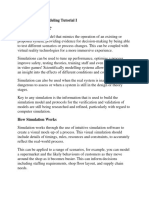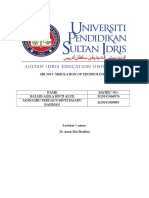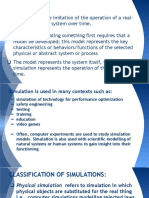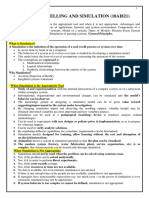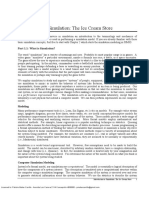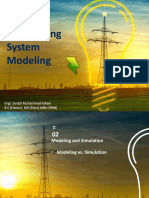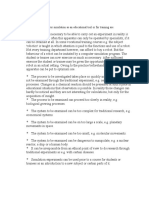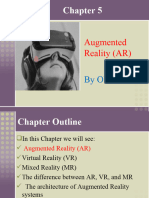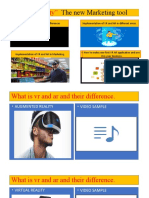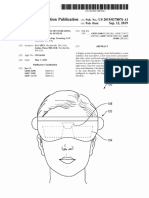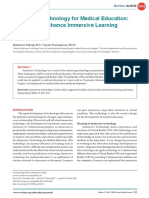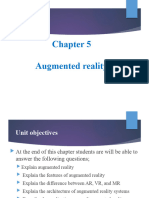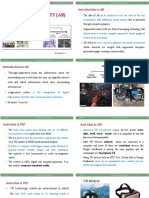Module 8. Simulation
Uploaded by
lonymarasiganModule 8. Simulation
Uploaded by
lonymarasiganRepublic of the Philippines
POLYTECHNIC UNIVERSITY OF THE PHILIPPINES
Office of the Vice President for Branches & Satellite Campuses
BANSUD ORIENTAL MINDORO BRANCH
MODULE 8. SIMULATION
OVERVIEW:
Simulation is a powerful and widely used technique that involves creating an imitative
representation (a "model") of a real-world process, system, or phenomenon. The purpose of
simulation is to conduct experiments with this model to understand its behavior, predict outcomes,
test different scenarios, or evaluate various strategies without having to manipulate the real
system itself. This makes simulation an invaluable tool in a vast array of fields, from engineering
and manufacturing to science, economics, education, and even entertainment.
MODULE OBJECTIVES:
After studying this module, you should be able to:
a. Evaluate the concept of simulation
b. Analyze a suitable problem to practice on.
c. Design a simulation model.
d. Establish the simulated model.
e. Analyze the results.
COURSE MATERIALS:
Simulation
A simulation is a model that mimics the operation of an existing or proposed system, providing
evidence for decision-making by being able to test different scenarios or process changes. This
can be coupled with virtual reality technologies for a more immersive experience.
Simulations can be used to tune up performance, optimize a process, improve safety, testing
theories, training staff and even for entertainment in video games! Scientifically modelling systems
allows a user to gain an insight into the effects of different conditions and courses of action.
Simulation can also be used when the real system is inaccessible or too dangerous to assess or
when a system is still in the design or theory stages.
Key to any simulation is the information that is used to build the simulation model and protocols
for the verification and validation of models are still being researched and refined, particularly
regarding computer simulation.
Why is Simulation Used?
Simulation is used to evaluate the effect of process changes, new procedures and capital
investment in equipment. Engineers can use simulation to assess the performance of an existing
system or predict the performance of a planned system, comparing alternative solutions and
designs.
Simulation is used as an alternative to testing theories and changes in the real world, which can
be costly. Simulation can measure factors including system cycle times, throughput under
different loads, resource utilization, bottlenecks and choke points, storage needs, staffing
requirements, effectiveness of scheduling and control systems.
There are many examples of simulation across industry, entertainment, education, and more.
Here are a few notable examples:
Automotive
Simulation allows the characteristics of a real vehicle to be replicated in a virtual environment, so
that the driver feels as if they are sitting in a real car. Different scenarios can be mimicked so that
the driver has a fully immersive experience. These types of simulators can help train both new
Lambot St., Poblacion, Bansud, Oriental, Mindoro
Direct line: (043) 738-6561 | Cell phone: 0910-788-6089
Website: www.pup.edu.ph E-mail: bansud@pup.edu.ph
THE COUNTRY’S 1st POLYTECHNICU
Republic of the Philippines
POLYTECHNIC UNIVERSITY OF THE PHILIPPINES
Office of the Vice President for Branches & Satellite Campuses
BANSUD ORIENTAL MINDORO BRANCH
and experienced drivers, offering a route to teach driving skills that can reduce maintenance and
fuel costs and ensure the safety of the drivers themselves.
Biomechanics
Simulation can be applied to biomechanics to create models of human or animal anatomical
structures to study their function and design medical treatments and devices. Biomechanics
simulation can also be used to study sports performance, simulate surgical procedures, and
assess joint loads. An additional example is neuromechanical simulation that unites neural
network simulation with biomechanics to test hypotheses in a virtual environment.
City and Urban Planning
Simulation can be used to design new cities and urban environments as well as to test how
existing urban areas can evolve because of policy decisions. This includes city infrastructure and
traffic flow among other potential models.
Digital Lifecycle Design
Simulations can assist with product design, allowing digital prototyping and testing to create better
performing products with a shorter time-to-market, while also assessing the lifecycle of the
finished product.
Disaster Preparation
Simulations can replicate emergency situations, to help with disaster preparedness. This includes
training and designing responses to events such as natural disasters, pandemics or terrorist
attacks. Responses can be tracked and assessed through the simulation, highlighting potential
problems and areas where more training may be required for responders, as well as ensuring any
mistakes are made in a safe environment ahead of any real-life event.
Economics and Finance
Economics, macroeconomics and finance also benefit from simulations. A mathematical model
of the economy can, for example, be tested using historical data as a proxy for the actual
economy. This can be used to assess inflation, unemployment, balance of trade and budgets.
Elsewhere, simulations can replicate the stock exchange or be used to test financial models.
Banks also use simulations to replicate payment and securities settlement systems.
Engineering Systems
Simulation is widely used for engineering systems to imitate operations and functions of
equipment, processes and procedures. Engineering simulations can combine mathematical
models and computer-assisted simulation for design or improvement of existing processes.
Ergonomics
Simulation can be used to analyze virtual products and working environments incorporating an
anthropometric virtual representation of the human, also known as a mannequin or Digital Human
Model (DHM). These DHMs can mimic the performance and capabilities of humans in simulated
environments. This type of simulation has applications ranging from assembly lines to disaster
management and video gaming to waste collection.
Flight Simulation
Flight simulators have been used for years to train new pilots in a safe environment. This not only
allows pilots to be assessed safely but can also test instrument failures and other problems
without risking the pilot, the instructor or the aircraft. You can also easily repeat the exact same
scenarios, such as approaching a runway to land, under different conditions, not to mention saving
fuel and other costs compared to actual flying time.
Marine Craft Simulation
Much like flight simulation, it is also possible to simulate working in a ship or submarine.
Simulators can include those that mimic the bridge, engine rooms, cargo handling bays,
communications or remotely operated vehicles. These are used in training institutions, colleges
and navies.
Lambot St., Poblacion, Bansud, Oriental, Mindoro
Direct line: (043) 738-6561 | Cell phone: 0910-788-6089
Website: www.pup.edu.ph E-mail: bansud@pup.edu.ph
THE COUNTRY’S 1st POLYTECHNICU
Republic of the Philippines
POLYTECHNIC UNIVERSITY OF THE PHILIPPINES
Office of the Vice President for Branches & Satellite Campuses
BANSUD ORIENTAL MINDORO BRANCH
Military Applications
Sometimes referred to as ‘war games,’ military simulations can be used to test out military plans
in a virtual environment using computer models. These can also incorporate social and political
factors and are used by governments and military organizations around the world.
Network Systems
Simulations have been applied to network and distributed systems to test new algorithms and
protocols before they are implemented in live systems. These can be applied to applications
including content delivery networks, smart cities and the Internet of Things.
Project Management
Simulation can be used for project management analysis and training purposes. Whether training
managers or analyzing the outcomes of different decisions, simulation is frequently conducted
with software tools.
Robotics
Robotics simulations are used to mimic situations that may not be possible to recreate and test in
real life due to time, cost or other factors. The results of these tests can then be assessed and
transferred to real life robots.
Production Systems
Production systems can be simulated using methods such as discrete event simulation to assess
manufacturing processes, assembly times, machine set-up, and more.
Sales
Sales can be simulated to examine the flow of transactions and customer orders as well as costs,
labor times and more.
Satellites and Space
The Kennedy Space Centre used simulation to train space shuttle engineers for launch
operations. This would see people interact with a simulated shuttle and ground support
equipment. Simulation is also used for satellite navigation tests.
Sport
Statistics are widely used as part of sport simulation to predict the outcome of events and the
performance of individual sportspeople. Sports simulation can also be used to predict the
outcome of games and events as well as for fantasy sports leagues. Biomechanics models can
also be used to assist training, assess fatigue levels and their effect on performance and more.
Weather
Weather forecasting uses simulations based on past data to predict extreme weather conditions
such as hurricanes or cyclones.
https://www.twi-global.com/technical-knowledge/faqs/faq-what-is-simulation
8.1. COMBINED SIMULATION
Combined simulation refers to the integration of two or more types of simulation models
(discrete-event, continuous) to analyze complex systems. These models work together to address
challenges that individual simulations cannot solve effectively.
Example: Simulating a hospital’s workflow by combining patient flow (discrete event) and disease
progression (continuous).
Key Simulation Types
1. Discrete-Event Simulation (DES): Models events occurring at distinct points in time.
2. Continuous Simulation: Represents systems evolving over time through continuous state
changes.
Lambot St., Poblacion, Bansud, Oriental, Mindoro
Direct line: (043) 738-6561 | Cell phone: 0910-788-6089
Website: www.pup.edu.ph E-mail: bansud@pup.edu.ph
THE COUNTRY’S 1st POLYTECHNICU
Republic of the Philippines
POLYTECHNIC UNIVERSITY OF THE PHILIPPINES
Office of the Vice President for Branches & Satellite Campuses
BANSUD ORIENTAL MINDORO BRANCH
3. Agent-Based Simulation (ABS): Models individual agents and their interactions within a
system.
Why used Combined Simulation?
• Holistic Analysis: Capture both macro and micro-level dynamics.
• Improved Accuracy: Enhances realism by modeling diverse aspects of a system.
• Flexibility: Adapts to various scenarios and complexities
Example: Traffic simulation combining vehicle flow (continuous) and driver behavior (agent
based)
Figure 1. Traffic Simulation
(A PTV Vissim simulation of drivers and cyclists in Copenhagen)
https://blog.ptvgroup.com/en/modeling-planning/realistic-traffic-simulation-driving-behavior-is-
key/
Example: Combined Simulation in Supply Chain Management
• Discrete-Event Simulation: Models production schedules and logistics.
• Agent-Based Simulation: Models behavior of suppliers, retailers and customers.
• Continuous Simulation: Tracks inventory levels and demand trends over time.
Figure 2. Multi-stage supply chain
Lambot St., Poblacion, Bansud, Oriental, Mindoro
Direct line: (043) 738-6561 | Cell phone: 0910-788-6089
Website: www.pup.edu.ph E-mail: bansud@pup.edu.ph
THE COUNTRY’S 1st POLYTECHNICU
Republic of the Philippines
POLYTECHNIC UNIVERSITY OF THE PHILIPPINES
Office of the Vice President for Branches & Satellite Campuses
BANSUD ORIENTAL MINDORO BRANCH
https://www.anylogic.com/resources/articles/a-simulation-approach-for-multi-stage-supply-
chain-optimization-to-analyze-real-world-transportation/
Key Challenges
• Integration Complexity: Ensuring seamless communication between different models.
• Computational Costs: Higher resource demands due to multiple models.
• Validation: Difficult to validate combined models due to their complexity.
https://www.slideshare.net/slideshow/combined_simulation-and-some-other-detail-
about/274757311
8.2. THE ROLE OF SIMULATION IN DIGITAL SYSTEM DESIGN
Simulation plays a crucial role in digital system design, facilitating various stages from initial
concept to final implementation. It's used for performance prediction, algorithm development,
hardware refinement, verification of correctness, and ensuring performance targets are met. The
varying simulation objectives require different levels of modeling detail, allowing designers to
trade off performance for model detail.
1. Early Design Stages
• Performance Prediction and Analysis: High-level simulation helps estimate the
performance of a proposed system before significant resources are invested in
detailed design.
• Identifying Potential Issues: Simulations can reveal potential problems early on,
such as timing hazards or resource conflicts, allowing designers to address them
before they become major obstacles.
2. Middle Design Stages:
• Software Algorithm Development: Simulation allows designers to develop and
test software algorithms that will run on the target hardware.
• Hardware Refinement: Simulations can be used to refine hardware designs, such
as optimizing circuit layouts or testing the performance of different architectural
choices.
3. Later Design Stages:
• Performance Validation: Simulations are used to verify that the final design
meets performance targets, such as speed, throughput, and power consumption.
• Hardware and Software Verification: Simulation helps ensure that the hardware
and software work correctly together, identifying potential bugs or inconsistencies.
Benefits of Simulation in Digital System Design
• Improved Design Efficiency: Identifying faulty designs early and gaining insight into
circuit behavior before building.
• Cost and Time Savings: Reduces the need for physical prototypes and allows for faster
iteration and testing of designs, saving significant money and time.
• Enhanced Reliability and Performance: Enables optimization and identification of
potential issues, leading to more robust and higher-performing digital systems.
• Reduced Risk of Failure: Allows engineers to predict and fix problems before anything
is built, preventing costly mistakes and potential disasters.
• Increased Collaboration: Cloud-based simulation and immersive technologies facilitate
sharing designs and collaborating globally.
• Support for Sustainable Decisions: Simulation can help optimize resource-saving
processes and minimize energy consumption, contributing to environmentally friendly
designs.
Lambot St., Poblacion, Bansud, Oriental, Mindoro
Direct line: (043) 738-6561 | Cell phone: 0910-788-6089
Website: www.pup.edu.ph E-mail: bansud@pup.edu.ph
THE COUNTRY’S 1st POLYTECHNICU
Republic of the Philippines
POLYTECHNIC UNIVERSITY OF THE PHILIPPINES
Office of the Vice President for Branches & Satellite Campuses
BANSUD ORIENTAL MINDORO BRANCH
https://ieeexplore.ieee.org/document/724553
https://www.esi-group.com/blog/what-is-system-simulation-software
https://www.ansys.com/simulation-topics/what-is-simulation
https://www.esi-group.com/blog/what-is-system-simulation-
software#:~:text=This%20approach%20is%20key%20to,interaction%20between%20hardware
%20and%20software.
8.3. SIMULATION RESULTS VISUALIZATION
Simulation is a powerful technique to model complex systems and processes, such as physics,
biology, engineering, or economics. However, simulation results can be hard to interpret and
communicate without effective visualization tools. Here are some of the most common ways to
visualize simulation results, and how they can help you understand.
1. Graphs and charts
One of the simplest and most widely used ways to visualize simulation results is to use
graphs and charts, such as line plots, bar charts, histograms, scatter plots, or pie charts.
Graphs and charts can show trends, patterns, distributions, correlations, or proportions of
simulation data. They can also compare different scenarios, parameters, or outcomes of
the simulation. Graphs and charts are easy to create and customize with various software
and libraries, such as Excel, MATLAB, R, Python, or D3.js.
2. Maps and spatial data
Another common way to visualize simulation results is to use maps and spatial data, such
as heat maps, contour maps, choropleth maps, or point maps. Maps and spatial data can
show the geographical location, distribution, or variation of simulation data. They can also
show the spatial relationships, interactions, or dynamics of the simulated entities, such as
agents, nodes, or regions. Maps and spatial data are useful for simulation models that
involve spatial dimensions, such as ecology, epidemiology, urban planning, or
transportation. Maps and spatial data can be created and manipulated with software and
libraries, such as ArcGIS, QGIS, Leaflet, or Google Maps.
3. Animations and videos
A third common way to visualize simulation results is to use animations and videos, such
as GIFs, MP4s, or interactive web applications. Animations and videos can show the
temporal evolution, behavior, or movement of simulation data. They can also show the
emergent properties, phenomena, or outcomes of the simulation. Animations and videos
are appealing for simulation models that involve dynamic processes, such as cellular
automata, agent-based models, or fluid dynamics. Animations and videos can be
generated and edited with software and libraries, such as Blender, Processing, Unity, or
Plotly.
4. Tables and dashboards
A fourth common way to visualize simulation results is to use tables and dashboards, such
as spreadsheets, grids, or panels. Tables and dashboards can show the numerical values,
statistics, or indicators of simulation data. They can also show the summary, overview, or
details of the simulation. Tables and dashboards are practical for simulation models that
involve quantitative analysis, such as optimization, decision making, or performance
evaluation. Tables and dashboards can be created and displayed with software and
libraries, such as Excel, Tableau, Shiny, or Dash.
5. Networks and graphs
A fifth common way to visualize simulation results is to use networks and graphs, such as
nodes, links, trees, or clusters. Networks and graphs can show the structure, connectivity,
or hierarchy of simulation data. They can also show the influence, dependency, or
similarity of the simulated entities, such as actors, variables, or concepts. Networks and
graphs are relevant for simulation models that involve relational aspects, such as social
Lambot St., Poblacion, Bansud, Oriental, Mindoro
Direct line: (043) 738-6561 | Cell phone: 0910-788-6089
Website: www.pup.edu.ph E-mail: bansud@pup.edu.ph
THE COUNTRY’S 1st POLYTECHNICU
Republic of the Philippines
POLYTECHNIC UNIVERSITY OF THE PHILIPPINES
Office of the Vice President for Branches & Satellite Campuses
BANSUD ORIENTAL MINDORO BRANCH
networks, systems dynamics, or knowledge representation. Networks and graphs can be
constructed and visualized with software and libraries, such as Gephi, NetworkX,
Graphviz, or Cytoscape.
Figure 3. Example of Visualizing Simulation Results using Frequency and Cumulative
Frequency Chart
https://www.linkedin.com/advice/0/what-most-common-ways-visualize-simulation-results-2scqe
https://www.solver.com/simulation-analysis
8.4. INTERACTIVE SIMULATION
Interactive simulations are virtual environments that mimic the scenario or functioning of a real-
life system. They can be used to provide effective learning in an experiential form. When applied
to a learning system, simulations use technologies like augmented reality (AR) and virtual reality
(VR) to ensure a realistic experience. The interactive features of a simulated environment
augment the immersive experiences offered by it. Such environments create dynamic situations
that encourage learners to develop their understanding of the topic through interactions.
They are particularly effective in fields requiring complex decision-making, from healthcare to
engineering and beyond. By designing real-time feedback and adaptive learning paths into your
next learning experience, you can provide simulations that offer a safe environment for learners
to experiment and learn from both success and failure.
Why Interactive Simulations work?
Interactive simulations perform well because they engage learners actively rather than passively.
Cognitive learning theories indicate that active involvement enhances understanding and
retention. Simulations allow learners to visualize abstract concepts, manipulate variables, and
see the consequences of their actions in an immersive, risk-free setting. This interactivity not only
consolidates learning but also enhances problem-solving skills and critical thinking.
Benefits
• Enhances engagement and retention through active participation.
• Provides a safe environment for experiential learning.
• Fosters critical thinking and problem-solving skills.
• Enables personalized learning experiences through adaptive feedback.
Risks
• High development costs and resource intensity.
• Potential technical issues impacting user experience.
• Overly complex simulations can overwhelm learners.
• Misalignment with learning outcomes if not carefully designed.
Lambot St., Poblacion, Bansud, Oriental, Mindoro
Direct line: (043) 738-6561 | Cell phone: 0910-788-6089
Website: www.pup.edu.ph E-mail: bansud@pup.edu.ph
THE COUNTRY’S 1st POLYTECHNICU
Republic of the Philippines
POLYTECHNIC UNIVERSITY OF THE PHILIPPINES
Office of the Vice President for Branches & Satellite Campuses
BANSUD ORIENTAL MINDORO BRANCH
Watch this video for an example of Interactive Simulation:
https://www.youtube.com/watch?v=KBfxnayIlOY
https://www.youtube.com/watch?v=OwfPdmMKQr0&t=33s
https://kitaboo.com/bringing-learning-to-life-with-interactive-simulations/
https://www.coursensu.com/blog/interactive-simulations-designing-learning-experiences-to-
connect-theory-and-practice
8.5. VIRTUAL REALITY
Virtual reality, or VR, is a simulated three-dimensional (3D) environment that lets users explore
and interact with a virtual surrounding in a way that approximates reality, as it's perceived through
the users' senses. The environment is created with computer hardware and software, although
users might also need to wear devices such as goggles, headsets or bodysuits to interact with
the environment. The more deeply users can immerse themselves in a VR environment -- and
block out their physical surroundings -- the more they can suspend their belief and accept it as
real, even if it's fantastical in nature.
When was virtual reality invented?
The history of VR dates to the 1960s, when computer scientist Ivan Sutherland created a
prototype head-mounted display (HMD) that could display basic wireframe graphics. Since then,
VR technology has advanced significantly, with the development of more sophisticated HMDs,
motion tracking, and haptic feedback systems. Nowadays, there are various terms referring to the
creation of digital realities: Augmented reality (AR) vs. virtual reality (VR) vs. mixed reality. But
what is the difference?
Augmented reality (AR), virtual reality (VR), and mixed reality (MR) are often used
interchangeably, but they are distinct technologies:
• AR adds digital elements to the real world, while VR creates a completely immersive digital
environment
• MR combines elements of both AR and VR, overlaying digital objects onto the real world
while also allowing for interaction with virtual elements
• VR: While in AR an additional layer of information extends reality, this is not the case with
VR. Here, it is a matter of leaving the real world and using virtual reality glasses to immerse
oneself specifically in a separate universe
In terms of applications, AR is often used in fields such as advertising, retail, and gaming, while
VR is more commonly used in industries such as healthcare, architecture, and education. MR, on
the other hand, has applications in both entertainment and professional settings, such as virtual
product demonstrations or training simulations.
How does virtual reality work?
Virtual reality (VR) works by simulating a realistic 3D environment through a combination of
hardware and software.
The functioning of VR technology
The basis of VR technology is an end-to-end mechanism that replaces the natural environment
with a deceptively real-looking simulation.
This simulation is strongly oriented to the real world. To adapt the digital world to the real world
as best as possible, modern AI algorithms are usually used. These have the task of projecting
new and familiar elements onto a mathematically defined surface. The result is a virtual world that
looks deceptively real to users.
Lambot St., Poblacion, Bansud, Oriental, Mindoro
Direct line: (043) 738-6561 | Cell phone: 0910-788-6089
Website: www.pup.edu.ph E-mail: bansud@pup.edu.ph
THE COUNTRY’S 1st POLYTECHNICU
Republic of the Philippines
POLYTECHNIC UNIVERSITY OF THE PHILIPPINES
Office of the Vice President for Branches & Satellite Campuses
BANSUD ORIENTAL MINDORO BRANCH
The hardware typically includes a headset or display, motion controllers, and sensors that track
the user’s movements and gestures in real-time. The software involves creating a digital
environment using computer-generated graphics, audio, and other sensory inputs to simulate a
fully immersive experience.
Different types of virtual reality
There are several different types of virtual reality, including fully immersive VR, where the user is
completely immersed in a digital environment; semi-immersive VR, which offers a more limited
immersive experience; and non-immersive VR, which uses a computer screen or projection
system to display a 3D environment without the user being fully immersed.
1. None-immersive virtual reality: None-immersive VR allows only a minimum of
interaction with the digital environment. Classic examples are video games or a driving
simulator in a driving school
2. Semi-immersive virtual reality: In semi-immersive VR, digital components overlay real
objects. The result is that these virtual elements can be used in a similar way to real
objects. This makes semi-immersive VR ideal for educational purposes. Common
examples are pilot training or the deepening of technical skills
3. Immersive virtual reality: In a fully immersive virtual reality, users perceive only the
virtual environment. There is no fixed point of reference to the real-world during use.
Currently, fully immersive VR technology is found primarily in the gaming industry. Special
data glasses, gloves, treadmills or sensory detectors are used here. They all contribute to
making the digital environment seem completely real. What is virtual reality and what is
the real environment cannot be answered theoretically in such a setting
4. Augmented reality: Augmented reality is also a form of virtual reality. The main difference
between the two approaches is the way developers realize the overlap of both worlds. A
well-known example of the use of AR are the so-called smart glasses. For instance, with
this tool, it is possible for employees to access real-time data in warehouses
5. Mixed reality: Mixed reality combines the physical and virtual worlds. It is a special form
of augmented reality but is increasingly used in marketing. This technology makes it
possible to visualize people or objects in a real context
Virtual reality: Benefits
1. One of the primary advantages of VR is its ability to create immersive experiences that
can help individuals learn, practice, and explore in a safe and controlled
environment. In the field of education, VR can be used to provide students with hands-
on experiences that would otherwise be too difficult, expensive, or dangerous to replicate
in real life. In a virtual reality simulator, specialists can pass on their knowledge in a
targeted manner to less experienced colleagues. At the same time, they can train their
own skills in the virtual environment. For this reason, the use of VR has already become
established in the aircraft and machine industry sector. Additionally, VR can be used in
the field of healthcare to simulate surgeries and train medical professionals
2. Virtual reality supports the personalization of virtual experiences. Haptic and audio
stimuli play a central role here. In the long term, VR should make it possible to tailor the
user experience to the individual user. This would open entirely new possibilities in the
areas of marketing, entertainment and education
3. Branding and product realization are also much easier in Virtual reality. The reason for
this is that projects can be implemented faster and more cost-effectively. At the same time,
experts can participate in meetings from different locations
4. Virtual reality makes it possible to hold meetings, training sessions or conferences in
virtual rooms. This eliminates the need to travel to the respective locations. Time flexibility
and location independence are the decisive factors here, making the technology more
important.
5. VR could make collaboration in companies much easier. At the same time, employees
from different locations would have the opportunity to meet directly in the digital space
Lambot St., Poblacion, Bansud, Oriental, Mindoro
Direct line: (043) 738-6561 | Cell phone: 0910-788-6089
Website: www.pup.edu.ph E-mail: bansud@pup.edu.ph
THE COUNTRY’S 1st POLYTECHNICU
Republic of the Philippines
POLYTECHNIC UNIVERSITY OF THE PHILIPPINES
Office of the Vice President for Branches & Satellite Campuses
BANSUD ORIENTAL MINDORO BRANCH
6. Moreover, Virtual reality technology has the potential to transform the entertainment
industry, creating immersive gaming experiences that allow players to become fully
immersed in a virtual world.
Why is virtual reality so important?
Virtual reality (VR) is important because it has the potential to transform how we interact with
and experience the world around us. It provides a new way of experiencing information,
allowing individuals to learn, practice, and explore in a safe and controlled environment.
Additionally, VR can help to bridge the gap between physical and virtual experiences,
creating immersive experiences that can be used for training, therapy, entertainment, and more.
As technology continues to advance, virtual reality is poised to become an increasingly important
part of our lives, impacting everything from education and healthcare to gaming and
entertainment.
Possible challenges
Despite its many benefits, VR technology is not without its challenges. One of the biggest
obstacles to widespread adoption is the cost of equipment and development, which can be
prohibitive for many organizations and individuals. At the same time, VR technology is not yet
equally available in all countries around the world. This is also since research in this area has
not yet been fully completed.
In addition, there are concerns that VR can cause motion sickness or other adverse health
effects, especially for individuals who are prone to these ailments. Apart from that, immersion in
virtual worlds can only work properly with sufficient computing power and memory.
Use cases: Virtual reality put into practice
Virtual reality (VR) technology offers a wide range of use cases across various industries. Here
are some of the most common applications of VR:
• Gaming and Entertainment: VR offers gamers an immersive experience, allowing them
to become fully immersed in a virtual world. From action-packed games to interactive
experiences, VR provides a new way to enjoy entertainment
• Education and Training: VR can be used in education and training to provide students
with hands-on experiences that would otherwise be difficult, expensive, or dangerous to
replicate in real life. For example, VR can be used to simulate a science experiment,
provide medical students with surgical simulations, or train pilots in flight simulations
• Healthcare: VR can be used in healthcare to help diagnose and treat medical conditions.
For example, VR can be used to help patients with anxiety disorders to overcome their
fears or to provide pain management therapy for chronic pain sufferers
• Real Estate and Architecture: VR can be used in real estate and architecture to provide
clients with a virtual tour of a property or building, helping them to visualize the space and
make informed decisions
• Tourism and Hospitality: VR can be used in the tourism and hospitality industry to
provide virtual tours of destinations, allowing travelers to explore and experience a place
before they book a trip
• Marketing and Advertising: VR can be used in marketing and advertising to create
immersive experiences that engage consumers and promote brand awareness
Watch this video about Virtual Reality
https://www.youtube.com/watch?v=Z_0iFPRYAbI
Resources:
https://www.teamviewer.com/apac/solutions/use-cases/virtual-reality-vr/
https://www.techtarget.com/whatis/definition/virtual-reality
Lambot St., Poblacion, Bansud, Oriental, Mindoro
Direct line: (043) 738-6561 | Cell phone: 0910-788-6089
Website: www.pup.edu.ph E-mail: bansud@pup.edu.ph
THE COUNTRY’S 1st POLYTECHNICU
Republic of the Philippines
POLYTECHNIC UNIVERSITY OF THE PHILIPPINES
Office of the Vice President for Branches & Satellite Campuses
BANSUD ORIENTAL MINDORO BRANCH
8.6. DESIGN AND CONTROL OF SIMULATION EXPERIMENTS
Simulation experiments are powerful tools for industrial engineers to test and optimize complex
systems, such as manufacturing processes, supply chains, or service operations. Designing and
controlling simulation experiments is a critical aspect of effectively using simulation models to gain
insights and make informed decisions. It involves applying principles of experimental design,
typically borrowed from statistics to the unique challenges and opportunities presented by
computer simulations. Here’s how to design and conduct simulation experiments like a pro, using
a systematic and rigorous approach that will help you achieve valid and reliable results.
1. Define the problem and objectives
The first step in any simulation experiment is to clearly define the problem and the
objectives of the experiment. What are you trying to achieve? What are the questions you
want to answer? What are the performance measures you want to evaluate? These
questions will help you focus your experiment on the most relevant aspects of the system
and avoid wasting time and resources on unnecessary details. You should also define the
scope and boundaries of the system, the assumptions and simplifications you will make,
and the data sources and requirements you will need.
2. Select the simulation model and software
The next step is to select the simulation model and the software that you will use to
implement it. The simulation model is a representation of the system that captures its
essential features and behaviors, such as the entities, resources, processes, logic, and
randomness. The simulation software is the tool that allows you to create, run, and analyze
the simulation model, such as Arena, Simul8, or AnyLogic. You should choose a
simulation model and a software that suit your problem and objectives, as well as your
level of expertise and available resources. You should also consider the type of simulation
you will use, such as discrete-event, continuous, or agent-based.
3. Build and verify the simulation model
The third step is to build and verify the simulation model using the simulation software.
This involves translating the system description into the simulation language, defining the
input parameters and variables, and coding the logic and rules of the system. You should
also verify that the simulation model is free of errors and bugs, and that it behaves as
expected. You can use various techniques to verify the simulation model, such as
debugging, tracing, animation, and checking the logic and output.
4. Validate the simulation model
The fourth step is to validate the simulation model, which means ensuring that it accurately
reflects the real system. You should compare the output of the simulation model with the
data from the real system, and check if they are statistically similar and within an
acceptable range of error. You should also test the sensitivity of the simulation model to
changes in the input parameters and variables and see if they produce reasonable and
consistent results. You can use various techniques to validate the simulation model, such
as face validity, historical validity, graphical validity, and statistical validity.
5. Design the simulation experiment
The fifth step is to design the simulation experiment, which means planning how you will
run the simulation model and collect the output data. You should define the experimental
factors and levels that you want to test, such as different scenarios, policies, or
alternatives. You should also define the number of replications and runs that you need to
obtain sufficient and accurate data, and the warm-up and run lengths that you need to
avoid transient and steady-state effects. You should also choose the appropriate random
number generators and seeds that you will use to generate the randomness in the
simulation model.
Lambot St., Poblacion, Bansud, Oriental, Mindoro
Direct line: (043) 738-6561 | Cell phone: 0910-788-6089
Website: www.pup.edu.ph E-mail: bansud@pup.edu.ph
THE COUNTRY’S 1st POLYTECHNICU
Republic of the Philippines
POLYTECHNIC UNIVERSITY OF THE PHILIPPINES
Office of the Vice President for Branches & Satellite Campuses
BANSUD ORIENTAL MINDORO BRANCH
6. Conduct and analyze the simulation experiment
The final step is to conduct and analyze the simulation experiment, which means
executing the simulation model and interpreting the output data. You should run the
simulation model according to the experimental design and collect the output data for each
factor and level combination. You should also analyze the output data using statistical
methods, such as descriptive statistics, confidence intervals, hypothesis tests, or ANOVA.
You should also report and communicate the results and findings of the simulation
experiment and provide recommendations and insights for the problem and objectives.
Control in Simulation Experiments
In simulation experiments, control refers to methods and techniques used to influence the
simulated system's behavior and ensure its stability and accuracy. The purpose is to manipulate
the simulation's variables in a controlled manner, influencing the outcome and enabling the study
of how the system responds to different conditions.
Various control techniques can be employed, including:
• Feedback control: Adjusting simulation parameters based on the output of the system,
creating a closed-loop system where the simulation constantly adjusts itself.
• Perturbation control: Applying small, carefully chosen changes to the simulation's initial
conditions or parameters to steer its behavior.
• State space control: Using state variables to monitor the simulation's status and make
decisions about how to manipulate the simulation's parameters.
Examples:
Weather prediction: Controlling the simulation of atmospheric models by adding perturbations
to steer the simulation towards a desired weather pattern or prevent extreme events.
Control systems: Simulating control systems (e.g., in power grids or robotics) and using control
algorithms to maintain stability and desired performance.
Medical simulations: Simulating physiological processes and using control mechanisms to
investigate the effects of interventions or drugs on the simulation.
Importance of Control in Simulation Experiments:
• Validity and Accuracy:
Control methods help ensure that the simulation accurately reflects the behavior of the
real-world system being modeled.
• Reproducibility:
Well-controlled simulations can be easily replicated and verified by others, ensuring that
the results are reliable.
• Optimization:
Control techniques can be used to optimize the performance of a simulated system or to
identify the best parameters for a particular process.
• Hypothesis Testing:
Control methods can be used to test specific hypotheses about how a system behaves
under different conditions.
https://www.linkedin.com/advice/0/how-can-you-design-conduct-simulation-experiments
https://www.sciencedirect.com/topics/earth-and-planetary-sciences/control-
simulation#:~:text=Control%20Simulation%20%2D%20an%20overview%20%7C%20ScienceDir
ect,Definition
Lambot St., Poblacion, Bansud, Oriental, Mindoro
Direct line: (043) 738-6561 | Cell phone: 0910-788-6089
Website: www.pup.edu.ph E-mail: bansud@pup.edu.ph
THE COUNTRY’S 1st POLYTECHNICU
Republic of the Philippines
POLYTECHNIC UNIVERSITY OF THE PHILIPPINES
Office of the Vice President for Branches & Satellite Campuses
BANSUD ORIENTAL MINDORO BRANCH
8.7. MODEL OPTIMIZATION
Model optimization in simulation, also known as simulation optimization, involves finding the best
input variable values for a simulation model to achieve the desired outcome or objective.
Simulation optimization can be defined as the process of finding the best input variable values
from among all possibilities without explicitly evaluating each possibility. The objective of
simulation optimization is to minimize the resources spent while maximizing the information
obtained in a simulation experiment. Optimization can deal with complex and nonlinear problems
and can incorporate multiple and conflicting criteria. Some examples of optimization are linear
programming, nonlinear programming, and multi-objective optimization.
Simulation optimization helps you make better resource allocation choices “here and now,” in
situations with uncertainty. You simply create a model that includes:
• Decision variables for resources you do control, just as in a conventional optimization
model
• Uncertain variables for factors you don’t control, just as in a Monte Carlo simulation
model
• An objective to maximize or minimize, that may depend on decision and uncertain
variables
• Constraints to satisfy, that may also depend on decision and uncertain variables.
Example:
Consider a drunk person wandering on a divided highway.
Random Position: ∑ ~ 𝑈𝑛𝑖𝑓𝑜𝑟𝑚[0,1, ]
dead if y != 1/2
Vital Status: 𝑓(𝑦) = {alive if y = 1/2
Figure 4. The Flaw of Averages: Deadly Highway
https://www.solver.com/simulation-optimization
https://people.orie.cornell.edu/shane/pubs/WSC2015TutSlides.pdf
https://www.informs-sim.org/wsc97papers/0118.PDF
https://www.linkedin.com/advice/0/how-do-you-choose-between-simulation-modeling
Lambot St., Poblacion, Bansud, Oriental, Mindoro
Direct line: (043) 738-6561 | Cell phone: 0910-788-6089
Website: www.pup.edu.ph E-mail: bansud@pup.edu.ph
THE COUNTRY’S 1st POLYTECHNICU
Republic of the Philippines
POLYTECHNIC UNIVERSITY OF THE PHILIPPINES
Office of the Vice President for Branches & Satellite Campuses
BANSUD ORIENTAL MINDORO BRANCH
8.8. GENERATING, TRANSFORMATION AND TESTING OF PSEUDORANDOM NUMBERS
Pseudo Random Number Generator (PRNG) refers to an algorithm that uses mathematical
formulas to produce sequences of random numbers. PRNGs generate a sequence of numbers
approximating the properties of random numbers. A PRNG starts from an arbitrary starting state
using a seed state. Many numbers are generated in a short time and can also be reproduced
later, if the starting point in the sequence is known. Hence, the numbers are deterministic and
efficient.
Why do we need PRNG?
With the advent of computers, programmers recognized the need for a means of introducing
randomness into a computer program. However, surprising as it may seem, it is difficult to get a
computer to do something by chance as computer follows the given instructions blindly and is
therefore completely predictable. It is not possible to generate truly random numbers from
deterministic things like computers, so PRNG is a technique developed to generate random
numbers using a computer.
Characteristics of PRNG
• Efficient: PRNG can produce many numbers in a short time and is advantageous for
applications that need many numbers
• Deterministic: A given sequence of numbers can be reproduced later if the starting point
in the sequence is known. Determinism is handy if you need to replay the same sequence
of numbers again at a later stage.
• Periodic: PRNGs are periodic, which means that the sequence will eventually repeat
itself. While periodicity is hardly ever a desirable characteristic, modern PRNGs have a
period that is so long that it can be ignored for most practical purposes
How PRNG works?
Linear Congruential Generator is most common and oldest algorithm for generating pseudo-
randomized numbers. The generator is defined by the recurrence relation:
We generate the next random integer using the previous random integer, the integer constants,
and the integer modulus. To get started, the algorithm requires an initial Seed, which must be
provided by some means. The appearance of randomness is provided by performing modulo
arithmetic.
Before looking at how we can construct pseudo-random numbers, let’s discuss some important
properties/considerations that need to be taken into account when generating pseudo-random
numbers:
• the random generation should be very fast. In practice, we want to use random numbers
to do other computations (for example simulate a little donut shop) and such computations
might be computationally intensive: if random generation were to be slow, we would not
be able to perform them.
Lambot St., Poblacion, Bansud, Oriental, Mindoro
Direct line: (043) 738-6561 | Cell phone: 0910-788-6089
Website: www.pup.edu.ph E-mail: bansud@pup.edu.ph
THE COUNTRY’S 1st POLYTECHNICU
Republic of the Philippines
POLYTECHNIC UNIVERSITY OF THE PHILIPPINES
Office of the Vice President for Branches & Satellite Campuses
BANSUD ORIENTAL MINDORO BRANCH
• the cycle of random generated numbers should be long. The cycle is the length of the
sequence before numbers start to repeat themselves.
• the random numbers should be repeatable. Given a starting point of the algorithm, it
should be possible to repeat the exact same sequence of numbers. This is fundamental
for debugging and for reproducibility.
• the method should be applicable in any programming language/platform.
• and of course, most importantly, the random numbers should be independent and
uniformly distributed.
Applications of PRNG
PRNGs are suitable for applications where many random numbers are required and where it is
useful that the same sequence can be replayed easily. Popular examples of such applications
are simulation and modeling applications. PRNGs are not suitable for applications where it is
important that the numbers are unpredictable, such as data encryption and gambling.
https://www.geeksforgeeks.org/pseudo-random-number-generator-prng/
https://bookdown.org/manuele_leonelli/SimBook/generating-pseudo-random-numbers.html
8.9. STOCHASTIC MODELS
In the context of simulation, stochastic models are computational models that incorporate
randomness and uncertainty into their structure. They allow for the simulation of systems where
outcomes are not deterministic but rather influenced by random variables, resulting in a range of
possible outcomes. These models are particularly useful when dealing with systems that exhibit
inherent variability or where certain parameters are not known with certainty.
Understanding Stochastic Models
For a model to be stochastic, it must have a random variable where a level of uncertainty exists.
Due to the uncertainty present in a stochastic model, the results provide an estimate of the
probability of various outcomes.
To estimate the probability of each outcome, one or more of the inputs must allow for random
variation over time. It results in an estimation of the probability distributions, which are
mathematical functions that show the likelihood of different outcomes.
For example, if you are analyzing investment returns, a stochastic model would provide an
estimate of the probability of various returns based on the uncertain input (e.g., market volatility).
The random variable typically uses time-series data, which shows differences observed in
historical data over time. The final probability distributions result from many stochastic projections
that reflect the randomness in the inputs.
Stochastic models must meet several criteria that distinguish them from other probability models.
First, stochastic models must contain one or more inputs reflecting the uncertainty in the projected
situation. Generally, the model must reflect all aspects of the situation to project a probability
distribution correctly.
Probabilities are correlated to events within the model, which reflect the randomness of the inputs.
The probabilities are then used to make predictions or to provide relevant information about the
situation
To understand the concept of stochastic modeling, it helps to compare it to its opposite:
deterministic modeling.
Lambot St., Poblacion, Bansud, Oriental, Mindoro
Direct line: (043) 738-6561 | Cell phone: 0910-788-6089
Website: www.pup.edu.ph E-mail: bansud@pup.edu.ph
THE COUNTRY’S 1st POLYTECHNICU
Republic of the Philippines
POLYTECHNIC UNIVERSITY OF THE PHILIPPINES
Office of the Vice President for Branches & Satellite Campuses
BANSUD ORIENTAL MINDORO BRANCH
Deterministic Modeling Produces Constant Results
Deterministic modeling gives you the same exact results for a particular set of inputs, no matter
how many times you recalculate the model. Here, the mathematical properties are known. None
of them is random, and there is only one set of specific values and only one answer or solution to
a problem. With a deterministic model, the uncertain factors are external to the model.
Stochastic Modeling Produces Changeable Results
Stochastic modeling, on the other hand, is inherently random, and the uncertain factors are built
into the model. The model produces many answers, estimations, and outcomes—like adding
variables to a complex math problem—to see their different effects on the solution. The same
process is then repeated many times under various scenarios.
Who Uses Stochastic Modeling?
Stochastic modeling is used in a variety of industries around the world. The insurance industry,
for example, relies heavily on stochastic modeling to predict how company balance sheets will
look at a given point in the future. Other sectors, industries, and disciplines that depend on
stochastic modeling include stock investing, statistics, linguistics, biology, and quantum physics.
https://corporatefinanceinstitute.com/resources/data-science/stochastic-modeling/
https://www.investopedia.com/terms/s/stochastic-modeling.asp
8.10. MONTE CARLO METHOD
The Monte Carlo simulation is a mathematical technique that predicts possible outcomes of an
uncertain event. Computer programs use this method to analyze past data and predict a range of
future outcomes based on a choice of action. For example, if you want to estimate the first month’s
sales of a new product, you can give the Monte Carlo simulation program your historical sales
data. The program will estimate different sales values based on factors such as general market
conditions, product price, and advertising budget.
Why is the Monte Carlo simulation important?
The Monte Carlo simulation is a probabilistic model that can include an element of uncertainty or
randomness in its prediction. When you use a probabilistic model to simulate an outcome, you
will get different results each time. For example, the distance between your home and office is
fixed. However, a probabilistic simulation might predict different travel times by considering factors
such as congestion, bad weather, and vehicle breakdowns.
In contrast, conventional forecasting methods are more deterministic. They provide a definite
answer to the prediction and cannot factor in uncertainty. For instance, they might tell you the
minimum and maximum travel time, but both answers are less accurate.
Benefits of the Monte Carlo simulation
The Monte Carlo simulation provides multiple possible outcomes and the probability of each from
a large pool of random data samples. It offers a clearer picture than a deterministic forecast. For
Lambot St., Poblacion, Bansud, Oriental, Mindoro
Direct line: (043) 738-6561 | Cell phone: 0910-788-6089
Website: www.pup.edu.ph E-mail: bansud@pup.edu.ph
THE COUNTRY’S 1st POLYTECHNICU
Republic of the Philippines
POLYTECHNIC UNIVERSITY OF THE PHILIPPINES
Office of the Vice President for Branches & Satellite Campuses
BANSUD ORIENTAL MINDORO BRANCH
instance, forecasting financial risks requires analyzing dozens or hundreds of risk factors.
Financial analysts use the Monte Carlo simulation to produce the probability of every possible
outcome.
History of the Monte Carlo simulation
John von Neumann and Stanislaw Ulam invented the Monte Carlo simulation, or the Monte
Carlo method, in the 1940s. They named it after the famous gambling location in Monaco
because the method shares the same random characteristic as a roulette game.
What are the Monte Carlo simulation use cases?
Companies use Monte Carlo methods to assess risks and make accurate long-term predictions.
The following are some examples of use cases.
• Business
Business leaders use Monte Carlo methods to project realistic scenarios when making
decisions. For example, a marketer needs to decide whether it's feasible to increase the
advertising budget for an online yoga course. They could use the Monte Carlo
mathematical model on uncertain factors or variables such as the following:
o Subscription fee
o Advertising cost
o Sign-up rate
o Retention
• The simulation would then predict the impact of changes on these factors to indicate
whether the decision is profitable.
• Finance
Financial analysts often make long-term forecasts on stock prices and then advise their
clients of appropriate strategies. While doing so, they must consider market factors that
could cause drastic changes to the investment value. As a result, they use the Monte Carlo
simulation to predict probable outcomes to support their strategies.
• Online gaming
Strict regulations govern the online gaming and betting industry. Customers expect
gaming software to be fair and mimic the characteristics of its physical counterpart.
Therefore, game programmers use the Monte Carlo method to simulate results and
ensure a fair-play experience.
• Engineering
Engineers must ensure the reliability and robustness of every product and system they
create before making it available to the public. They use Monte Carlo methods to simulate
a product’s probable failure rate based on existing variables. For example, mechanical
engineers use the Monte Carlo simulation to estimate the durability of an engine when it
operates in various conditions.
How does the Monte Carlo simulation work?
The basic principle of the Monte Carlo simulation lies in ergodicity, which describes the statistical
behavior of a moving point in an enclosed system. The moving point will eventually pass through
every possible location in an ergodic system. This becomes the basis of the Monte Carlo
simulation, in which the computer runs enough simulations to produce the eventual outcome of
different inputs.
For example, a six-sided die has a one-sixth chance of landing on a specific number. When you
roll the die six times, you might not land the die on six different numbers. However, you will achieve
the theoretical probability of one-sixth for each number when you continue indefinitely rolling. The
Lambot St., Poblacion, Bansud, Oriental, Mindoro
Direct line: (043) 738-6561 | Cell phone: 0910-788-6089
Website: www.pup.edu.ph E-mail: bansud@pup.edu.ph
THE COUNTRY’S 1st POLYTECHNICU
Republic of the Philippines
POLYTECHNIC UNIVERSITY OF THE PHILIPPINES
Office of the Vice President for Branches & Satellite Campuses
BANSUD ORIENTAL MINDORO BRANCH
result accuracy is proportional to the number of simulations. In other words, running 10,000
simulations produces more accurate results than 100 simulations.
The Monte Carlo simulation works the same way. It uses a computer system to run enough
simulations to produce different outcomes that mimic real-life results. The system uses random
number generators to recreate the inherent uncertainty of the input parameters. Random number
generators are computer programs that produce an unpredictable sequence of random numbers.
What are the components of a Monte Carlo simulation?
A Monte Carlo analysis consists of input variables, output variables, and a mathematical model.
The computer system feeds independent variables into a mathematical model, simulates them,
and produces dependent variables.
• Input variables
Input variables are random values that affect the outcome of the Monte Carlo simulation.
For example, manufacturing quality and temperature are input variables that influence a
smartphone's durability. You can express input variables as a range of random value
samples so Monte Carlo methods can simulate the results with random input values.
• Output variable
The output variable is the result of the Monte Carlo analysis. For example, an electronic
device’s life expectancy is an output variable, with its value being a time such as 6 months
or 2 years. The Monte Carlo simulation software shows the output variable in a histogram
or graph that distributes the result in a continuous range on the horizontal axis.
• Mathematical model
A mathematical model is an equation that describes the relationship between output and
input variables in mathematical form. For example, the mathematical model for profitability
is Profit = Revenue − Expenses.
The Monte Carlo software replaces revenue and expenses with probable values based on the
probability distribution type. Then it repeats the simulation to get a highly accurate result. The
Monte Carlo simulation can run for hours when the mathematical model involves many random
variables.
What are probability distributions in the Monte Carlo simulation?
Probability distributions are statistical functions that represent a range of values distributed
between limits. Statistics experts use probability distributions to predict the possible occurrence
of an uncertain variable, which might consist of discrete or continuous values.
Discrete probability distribution is represented by whole numbers or a sequence of finite numbers.
Each of the discrete values has a probability greater than zero. Statisticians plot discrete
probability distribution on a table, but they plot continuous probability distribution as a curve
between two given points on the x-axis of a graph. The following are common types of probability
distributions that a Monte Carlo simulation can model.
• Normal distribution
Normal distribution, also known as the bell curve, is symmetrically shaped like a bell and
represents most real-life events. The possibility of a random value at the median is high,
and the probability significantly decreases toward both ends of the bell curve. For
example, a repeated random sampling of the weight of students in a particular classroom
gives you a normal distribution chart.
• Uniform distribution
Uniform distribution refers to a statistical representation of random variables with equal
chance. When plotted on a chart, the uniformly distributed variables appear as a horizontal
Lambot St., Poblacion, Bansud, Oriental, Mindoro
Direct line: (043) 738-6561 | Cell phone: 0910-788-6089
Website: www.pup.edu.ph E-mail: bansud@pup.edu.ph
THE COUNTRY’S 1st POLYTECHNICU
Republic of the Philippines
POLYTECHNIC UNIVERSITY OF THE PHILIPPINES
Office of the Vice President for Branches & Satellite Campuses
BANSUD ORIENTAL MINDORO BRANCH
flat line across the valid range. For example, the uniform distribution represents the
likelihood of rolling and landing on each side of a die.
• Triangular distribution
Triangular distribution uses minimum, maximum, and most-likely values to represent
random variables. Its probability peaks at the most-likely value. For example, companies
use triangular distribution to predict upcoming sales volumes by establishing the triangle's
minimum, maximum, and peak value.
What are the steps in performing the Monte Carlo simulation?
The Monte Carlo method involves the following steps.
• Establish the mathematical model
Define an equation that brings the output and input variables together. Mathematical
models can range from basic business formulas to complex scientific equations.
• Determine the input values
Choose from the different types of probability distributions to represent the input values.
For example, the operating temperature of a mobile phone is likely to be a bell curve since
the device runs at room temperature most of the time.
• Create a sample dataset
Create a large dataset of random samples based on the chosen probability distribution.
The sample size should be in the range of 100,000 to produce accurate results.
• Set up the Monte Carlo simulation software
Use the input samples and mathematical model to configure and run the Monte Carlo
simulation software. Result times can vary depending on the number of input variables,
and you might have to wait for the results.
• Analyze the results
Check the simulated results to find how the output distributes on the histogram. Use
statistical tools to calculate parameters, such as mean value, standard deviation, and
variant, to determine whether the result falls within your expectation.
What are the challenges of the Monte Carlo simulation?
These are two common challenges when using Monte Carlo simulations:
• The Monte Carlo simulation is highly dependent on the input values and distribution. If
mistakes are made when electing the input and probability distribution, it can lead to
inaccurate results.
• It might take excessive computational power to perform Monte Carlo experiments.
Computing with the Monte Carlo method can take hours or days to complete on a single
computer.
https://aws.amazon.com/what-is/monte-carlo-simulation/
https://www.geeksforgeeks.org/what-is-monte-carlo-simulation/
Lambot St., Poblacion, Bansud, Oriental, Mindoro
Direct line: (043) 738-6561 | Cell phone: 0910-788-6089
Website: www.pup.edu.ph E-mail: bansud@pup.edu.ph
THE COUNTRY’S 1st POLYTECHNICU
Republic of the Philippines
POLYTECHNIC UNIVERSITY OF THE PHILIPPINES
Office of the Vice President for Branches & Satellite Campuses
BANSUD ORIENTAL MINDORO BRANCH
8.11. OVERVIEW OF COMMONLY USED SIMULATION SYSTEMS
Simulation systems are software tools designed to build, run, and analyze models that mimic the
behavior of real-world or hypothetical systems. They are invaluable for understanding complex
interactions, identifying bottlenecks, optimizing processes, and making informed decisions
without the cost or risk of experimenting with the real system.
Here's an overview of commonly used simulation systems, categorized by their underlying
modeling paradigms:
1. Discrete Event Simulation (DES) Systems
In DES, the system's state changes only at discrete points in time, called "events."
Between events, the system's state remains unchanged. This paradigm is ideal for
modeling systems where items or entities move through a series of defined steps or
processes.
Common Applications:
• Manufacturing and Production: Production lines, factory layouts, assembly
processes, scheduling, capacity planning, bottleneck identification.
• Logistics and Supply Chain: Warehouse operations, transportation networks,
inventory management, distribution centers.
• Healthcare: Hospital patient flow, emergency room operations, appointment
scheduling, resource allocation.
• Service Systems: Call centers, customer queues, retail operations, banking.
Commonly Used Software:
• Arena (Rockwell Automation): A very popular and powerful DES software,
known for its flowchart-based modeling approach and extensive libraries. Widely
used in academia and industry.
• FlexSim: Offers robust 3D visualization and a user-friendly interface, particularly
strong for manufacturing, warehousing, and logistics.
• Simio: Combines discrete event simulation with object-oriented modeling, allowing
for hierarchical model building and reusability. Also supports agent-based and
continuous modeling.
• AnyLogic: A multi-method simulation tool that supports DES, Agent-Based
Modeling, and System Dynamics within a single environment. Highly flexible and
capable of complex industrial and business process modeling.
• ExtendSim: A block-based simulation environment, often used for process
modeling and decision-making in various industries.
• Witness (Lanner): A comprehensive DES package, offering strong 2D/3D
visualization and integration capabilities, often used in manufacturing.
• Simul8: Known for its ease of use and speed in building discrete event models,
particularly suitable for business process improvement.
2. Agent-Based Modeling (ABM) Systems
ABM focuses on individual, autonomous "agents" (e.g., people, vehicles, cells, products)
that interact with each other and their environment based on a set of rules. Complex
system-level behaviors (emergent properties) arise from these individual interactions.
Common Applications:
• Social Sciences: Crowd dynamics, diffusion of innovations, market behavior,
opinion formation.
• Ecology and Biology: Animal population dynamics, disease spread
(epidemiology), cellular interactions.
Lambot St., Poblacion, Bansud, Oriental, Mindoro
Direct line: (043) 738-6561 | Cell phone: 0910-788-6089
Website: www.pup.edu.ph E-mail: bansud@pup.edu.ph
THE COUNTRY’S 1st POLYTECHNICU
Republic of the Philippines
POLYTECHNIC UNIVERSITY OF THE PHILIPPINES
Office of the Vice President for Branches & Satellite Campuses
BANSUD ORIENTAL MINDORO BRANCH
• Traffic and Transportation: Vehicle movement, traffic congestion, pedestrian
flow.
• Supply Chain: Decentralized decision-making in complex networks.
• Business: Customer behavior, organizational dynamics.
Commonly Used Software:
• NetLogo: An excellent and widely used platform, particularly strong for educational
purposes and quickly prototyping ABMs due to its accessible programming
language.
• AnyLogic: As mentioned, it provides strong support for ABM, especially when
combined with DES or System Dynamics.
• Repast (Recursive Porous Agent Simulation Toolkit): A powerful and flexible open-
source toolkit (Java, Python, C++) for complex ABM development, often used in
academic research.
• MASON (Multi-Agent Simulator Of Neighborhoods): Another open-source,
Java-based toolkit focused on performance for large-scale ABMs.
• GAMA (GIS Agent-based Modeling Architecture): Focuses on spatially explicit
ABMs, often used in geographic and urban planning contexts.
• Mesa: A Python-based ABM framework that allows for rapid model creation,
visualization, and analysis using Python's data science ecosystem.
3. Continuous Simulation Systems (System Dynamics)
Continuous simulation models represent systems where state variables change
continuously over time, often described by differential equations. It focuses on the flows,
accumulations, and feedback loops within a system, rather than individual events or
entities. System Dynamics is a specific methodology within continuous simulation.
Common Applications:
• Strategic Planning: Business growth, market share dynamics, policy analysis,
resource sustainability.
• Environmental Science: Ecosystem dynamics, climate modeling, pollution
spread.
• Economics: Macroeconomic models, market fluctuations.
• Public Health: Disease progression, public health interventions.
• Engineering: Control systems, chemical processes (though often handled by
specialized process simulation software).
Commonly Used Software:
• Vensim (Ventana Systems): A leading professional software for System
Dynamics modeling, known for its powerful analysis capabilities and robust
handling of complex models.
• Stella Architect (isee systems): User-friendly visual modeling environment for
System Dynamics, often used for education and policy analysis.
• AnyLogic: Supports System Dynamics alongside DES and ABM.
• Powersim Studio: Another comprehensive System Dynamics tool for business and
policy analysis.
• Simulink (MATLAB): While a general-purpose block diagram environment, it is
widely used for continuous system simulation, especially in engineering and
control systems, by representing systems with differential equations.
4. Monte Carlo Simulation Software
Monte Carlo simulation is a broad class of computational algorithms that rely on repeated
random sampling to obtain numerical results. It's often used for risk analysis, uncertainty
quantification, and estimating outcomes where exact solutions are difficult to calculate due
Lambot St., Poblacion, Bansud, Oriental, Mindoro
Direct line: (043) 738-6561 | Cell phone: 0910-788-6089
Website: www.pup.edu.ph E-mail: bansud@pup.edu.ph
THE COUNTRY’S 1st POLYTECHNICU
Republic of the Philippines
POLYTECHNIC UNIVERSITY OF THE PHILIPPINES
Office of the Vice President for Branches & Satellite Campuses
BANSUD ORIENTAL MINDORO BRANCH
to randomness. It's often considered a static simulation as it generally takes a snapshot
of a system's state or a single outcome.
Common Applications:
• Financial Modeling: Option pricing, risk assessment (e.g., Value at Risk), portfolio
optimization.
• Project Management: Project completion time and cost estimation (e.g., PERT
analysis).
• Engineering: Reliability analysis, design optimization, error propagation.
• Scientific Research: Statistical inference, complex integral approximation.
Commonly Used Software/Tools:
• Microsoft Excel (with add-ins): Widely used for basic Monte Carlo simulations.
Add-ins like @RISK (Palisade Corporation's DecisionTools Suite) and Crystal Ball
(Oracle) greatly enhance Excel's capabilities for defining distributions, running
simulations, and analyzing results.
• Python (with libraries like NumPy, SciPy): A powerful and flexible environment
for implementing custom Monte Carlo simulations.
• R: Another statistical programming language with excellent capabilities for Monte
Carlo simulations.
• MATLAB: Strong for numerical computation and statistical analysis, suitable for
Monte Carlo simulations.
• Specialized tools: Some simulation platforms like FlexSim or Simio might
incorporate Monte Carlo analysis for their discrete event models.
5. Specialized Simulation Systems
Beyond these main paradigms, there are many specialized simulation systems for specific
domains:
• Finite Element Analysis (FEA) / Computational Fluid Dynamics (CFD): Used
in engineering for physical simulations (e.g., stress analysis, heat transfer, fluid
flow) based on partial differential equations. (e.g., ANSYS, Abaqus, COMSOL
Multiphysics, Autodesk CFD).
• Circuit Simulators: For designing and analyzing electronic circuits (e.g., SPICE,
Multisim).
• Flight Simulators: For pilot training and aircraft design.
• Gaming Engines: For developing video games, often incorporating physics and
AI simulations (e.g., Unity, Unreal Engine).
The choice of simulation system depends heavily on the nature of the system being modeled, the
objectives of the study, and the level of detail required. Often, complex problems benefit from a
"multi-method" approach, combining different simulation paradigms, which is supported by
platforms like AnyLogic.
Watch this video about AnyLogic Simulation Software
https://www.youtube.com/watch?v=9e0F4VtgoaQ
https://www.autodesk.com/solutions/simulation/overview#:~:text=Today%2C%20you%20can%2
0analyze%20the,over%20time%20using%20simulation%20software
https://www.anylogic.com/use-of-simulation/
https://www.simio.com/what-are-the-differences-between-simulation-software-discrete-
continuous-and-agent-based/
Lambot St., Poblacion, Bansud, Oriental, Mindoro
Direct line: (043) 738-6561 | Cell phone: 0910-788-6089
Website: www.pup.edu.ph E-mail: bansud@pup.edu.ph
THE COUNTRY’S 1st POLYTECHNICU
You might also like
- Introduction To Simulation: by Ajay ChedudoopNo ratings yetIntroduction To Simulation: by Ajay Chedudoop18 pages
- Introduction To Simulation Analysis: FunctionsNo ratings yetIntroduction To Simulation Analysis: Functions7 pages
- CSL403 Introduction To Modeling and Simulation: Lecture 1 (Date: 23/7/13 & 24/7/13)No ratings yetCSL403 Introduction To Modeling and Simulation: Lecture 1 (Date: 23/7/13 & 24/7/13)20 pages
- System Simulation and Modeling: Chapter One: IntroductionNo ratings yetSystem Simulation and Modeling: Chapter One: Introduction27 pages
- Chapter 1 Introduction To Modelling and SimulationNo ratings yetChapter 1 Introduction To Modelling and Simulation10 pages
- Ac 2008-708: Digital Manufacturing and Simulation CurriculumNo ratings yetAc 2008-708: Digital Manufacturing and Simulation Curriculum12 pages
- Simulation and Modelling Notes - Chapter One To Chapter 12.No ratings yetSimulation and Modelling Notes - Chapter One To Chapter 12.281 pages
- Modeling With Tecnomatix Plant SimulationNo ratings yetModeling With Tecnomatix Plant Simulation5 pages
- Chapter 01 Simulation Modeling With SIMIO A WorkbookNo ratings yetChapter 01 Simulation Modeling With SIMIO A Workbook20 pages
- Simulation Definition: Models Simulation Performance Tuning Safety Engineering Scientific ModelingNo ratings yetSimulation Definition: Models Simulation Performance Tuning Safety Engineering Scientific Modeling4 pages
- Advantages: Some Advantages of Computer Simulation As An Educational Tool or For Training AreNo ratings yetAdvantages: Some Advantages of Computer Simulation As An Educational Tool or For Training Are3 pages
- "Virtual Reality": The New Marketing ToolNo ratings yet"Virtual Reality": The New Marketing Tool11 pages
- Playing With The Past Into The Future 2nd Edition Erik Champion Instant Download100% (1)Playing With The Past Into The Future 2nd Edition Erik Champion Instant Download82 pages
- Module 8 The Internet and Social Media Part 3No ratings yetModule 8 The Internet and Social Media Part 320 pages
- Unveiling The Metaverse Exploring Emerging Trends Multifaceted Perspectives and Future ChallengesNo ratings yetUnveiling The Metaverse Exploring Emerging Trends Multifaceted Perspectives and Future Challenges17 pages
- Meta Quest 3 New Mixed Reality VR Headset - Shop Now Meta StoreNo ratings yetMeta Quest 3 New Mixed Reality VR Headset - Shop Now Meta Store1 page
- Immersive Technology For Medical Education: Technology Enhance Immersive Learning ExperiencesNo ratings yetImmersive Technology For Medical Education: Technology Enhance Immersive Learning Experiences7 pages
- 11 09 05sales Technology Selling With Augmented Realitylong 110905114717 Phpapp02 PDFNo ratings yet11 09 05sales Technology Selling With Augmented Realitylong 110905114717 Phpapp02 PDF14 pages
- Mixed Reality for Industrial MaintenanceNo ratings yetMixed Reality for Industrial Maintenance6 pages
- TheInnovationEdge-MobileAppsProducts and Services OverviewNo ratings yetTheInnovationEdge-MobileAppsProducts and Services Overview22 pages
- Augmented Virtual and Mixed Reality in Spinal SurgNo ratings yetAugmented Virtual and Mixed Reality in Spinal Surg12 pages
- Navisworks Hacks For Efficient Work Ows: November 2017No ratings yetNavisworks Hacks For Efficient Work Ows: November 201735 pages
- The Combination of Arti Ficial Intelligence and Extended Reality: A Systematic ReviewNo ratings yetThe Combination of Arti Ficial Intelligence and Extended Reality: A Systematic Review13 pages
- Microsoft Hololens I. Background of The StudyNo ratings yetMicrosoft Hololens I. Background of The Study6 pages
- Gujarat Technological University: PrerequisiteNo ratings yetGujarat Technological University: Prerequisite5 pages
- Emerging Technologies in Global Business Environment NiteshNo ratings yetEmerging Technologies in Global Business Environment Nitesh55 pages


